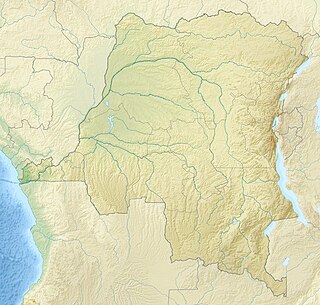Related Research Articles
Alphonse Briart (1825–1898) was supervisor of the coal mines at Bascoup and Mariemont near Morlanwelz in the Hainaut province of Belgium, and a geologist who studied that region. During the period 1863-1896 he and Francois Cornet published a number of books and papers describing fossils and geological structures found near Mons. They devised theories - now generally accepted - as to the geological history of the region. After Cornet's death in 1887, Briart continued to write alone.
Lepagia is an extinct genus of poorly known carnivorous cynodonts, which lived during the Upper Triassic in Europe. Partly due to the paucity of remains the precise affinities of this genus are unclear. It seems reasonably closely related to Probainognathus, a somewhat earlier inhabitant of South America. The genus Lepagia was named by Hahn, Wild and Wouters in 1987 based on a single species.
The Tournaisian is in the ICS geologic timescale the lowest stage or oldest age of the Mississippian, the oldest subsystem of the Carboniferous. The Tournaisian age lasted from 358.9 Ma to 346.7 Ma. It is preceded by the Famennian and is followed by the Viséan.
The Visean, Viséan or Visian is an age in the ICS geologic timescale or a stage in the stratigraphic column. It is the second stage of the Mississippian, the lower subsystem of the Carboniferous. The Visean lasted from 346.7 to 330.9 Ma. It follows the Tournaisian age/stage and is followed by the Serpukhovian age/stage.

Rouge de Rance is a Devonian red reef limestone from the town of Rance in the province of Hainaut.

Noir Belge is collective noun referring to black limestone found on several sites in Belgium. Some trade names refer more specifically to the quarry were the material was found, for example "Noir de Mazy" or "Noir de Golzinne". Some Noir belge marble deposit belongs to a fine-grained calcareous sedimentary formation dated Frasnian era and located on the northern border of Namur sedimentary basin. A few black limestones located in the lower Carboniferous
Congosaurus is an extinct genus of dyrosaurid mesoeucrocodylian. Fossils have been found from Lândana, in Angola and date back to the Paleocene epoch. In 1952 and 1964 Congosaurus was proposed to be synonymous with Dyrosaurus. The genus was later thought synonymous with Hyposaurus in 1976 and 1980. It has since been proven a distinct genus of dyrosaurid separate from both Dyrosaurus and Hyposaurus.

Philippe-Charles or Philip Carel Schmerling was a Dutch/Belgian prehistorian, pioneer in paleontology, and geologist. He is often considered the founder of paleontology.

Jules-Auguste Gosselet was a French geologist born in Cambrai, France.

The Muganja hills are a range in the Tanganyika District of Katanga Province in the Democratic Republic of the Congo, to the south of Kalemie.

Viesville is a village that forms part of the municipality of Pont-à-Celles in the Belgian province of Hainaut in the Walloon region, Belgium. The village is crossed by the Charleroi-Brussels Canal.
The Chappel Limestone is a geologic formation in Texas. It preserves fossils dating back to the Carboniferous period.
Doliognathus is an extinct genus of conodonts in the family Bactrognathidae from the Middle Dinantian. It is a genus of multielement conodonts.
Staurognathus is an extinct genus of conodonts in the family Bactrognathidae from the Middle Dinantian. It is a genus of multielement conodonts.
Proconodontus is an extinct genus of conodonts in the family Proconodontidae. The specimens are found in Cambrian formations.
Aphyllopteris is a poorly known genus of extinct Devonian land plants formerly placed in the Rhyniophytina. It is considered an artificial group for sterile naked axes that branch pseudomonopodially. Early Devonian records of this genus are found in Belgium, France, Norway, Poland, and Russia, and possibly Uzbekistan. Putative Middle to Late Devonian records of this genus include A. delawarensis reported from Frasnian outcrops in New York and Aphyllopteris sp. reported from the Givetian outcrops of the Beckers Butte Member of the Martin Formation in Arizona.
Scaliognathus is an extinct genus of conodonts.
Wilbert Henry Hass (1906-1959) was an invertebrate paleontologist specializing in the study of conodonts. He joined the Section of Paleontology and Stratigraphy of the United States Geological Survey (USGS) in 1930 when he was appointed Junior Scientific Aid. He was promoted to the rank of Geologist in 1940 and remained with the USGS for the remainder of his life.
Philippe Steemans is a Belgian geologist researcher, best known for his work on palynology. As a Senior Researcher of the National Fund for Scientific Research (NFSR) at the University of Liège, Belgium, in the Department of Geology, Steemans studies fossilised spores from Palaeozoic, mainly from their first occurrence in the Ordovician up to the Devonian.
John-Clay Purves MD (1825–1903) was a British geologist and museum curator.
References
- ↑ Conodonts from the Chappel limestone of Texas. Wilbert H. Hass, 1959
- ↑ The origin and evolution of the middle Dinantian conodont genera Doliognathus, Dollymae, Scaliognathus, and Staurognathus, and related forms. Ronald L. Austin and Eric Groessens, Annales de la Société géologique de Belgique, Volume 95 (1972), Fascicule 2, pages 229-238 (URL, retrieved 24 April 2016)
- ↑ Les conodontes du Tournaisien supérieur de la Belgique: note préliminaire. E Groessens, 1971, Service Géologique de Belgique